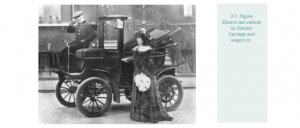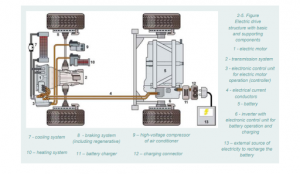Lesson 2: BEV – History and Electric drivetrain components and its structure
In this lesson, we’ll delve into the fascinating history of Battery Electric Vehicles (BEVs) and explore the key components that make up their electric drivetrain.
- Introduction to Battery Electric Vehicles (BEV)
- Battery Electric Vehicles (BEVs) are a type of electric vehicle that relies entirely on electric power for propulsion.
- BEVs are known for producing zero exhaust emissions, making them a vital part of sustainable transportation solutions.
- Advantages of Battery Electric Vehicles BEVs offer several advantages over traditional vehicles with internal combustion engines:
- Zero Emissions: BEVs produce no exhaust emissions during operation, contributing to cleaner air and reduced environmental impact.
- Low Noise Level: BEVs operate quietly, significantly reducing noise pollution in urban areas.
- Minimal Vibrations: The electric drivetrain in BEVs generates minimal vibrations, resulting in a smoother and more comfortable ride.
- Cold-Weather Performance: BEVs perform well in low temperatures, ensuring reliable operation even in winter conditions.
- Immediate Torque: Electric motors provide instant access to maximum torque, delivering rapid acceleration.
- High Energy Efficiency: BEVs are highly efficient in converting electrical energy into motion.
- Low Maintenance Costs: With fewer moving parts, BEVs have lower maintenance costs compared to vehicles with internal combustion engines.
- Low Operating Costs: BEVs are generally more cost-effective to operate due to the lower price of electricity compared to gasoline or diesel.
- Energy Independence: BEVs reduce dependence on petroleum products and allow for the use of domestic energy resources.
2.1 History of Battery Electric Vehicles
- The history of BEVs dates back to the late 19th century, with significant milestones:
- In 1879, Siemens showcased an electric vehicle that could pull smaller coaches at the World Exhibition in Berlin.
- By 1881, a tricycle powered by lead batteries was driven in Paris.
- In 1888, John Camp Starley built a small electric car in England.
- In 1894, the Electric Carriage and Wagon Co. started producing electric vehicles for commercial use.
- In 1899, the “Never Satisfied” reached a speed of 100 km/h, demonstrating the potential of electric propulsion.
- In 1900, approximately 38% of cars on American roads were electrically powered.
- However, limited battery capacity and charging infrastructure hindered widespread adoption.
- The resurgence of electric vehicles occurred in the mid-1960s due to traffic congestion, pollution concerns, and technological advancements.
- In 1974, Sebring-Vanguard produced the CitiCar, a small electric vehicle with a 48V electric motor.
- In 1996, General Motors introduced the EV1, a serial-production electric vehicle with improved performance and battery technology.

2.2 Electric Drivetrain Components and Structure
- The electric drivetrain in a BEV consists of several key components:
- Electric Motor: An electric motor converts electrical energy into mechanical energy, propelling the vehicle.
- Batteries: Batteries store electrical energy and provide power to the electric motor.
- Motor Control Unit (Controller): The controller regulates the electric current supplied to the motor based on driver input, ensuring efficient operation.
- Transmission System: The transmission system connects the electric motor to the drive wheels and may include a gearbox with variable gears or a reduction gear, depending on the vehicle’s design.
- The electric motor can be of various types, including three-phase alternating current motors, synchronous motors with permanent magnets, or direct current motors.

Conclusion
- Battery Electric Vehicles (BEVs) have a rich history and offer numerous advantages over traditional vehicles with internal combustion engines.
- Understanding the components of the electric drivetrain is essential for comprehending how BEVs operate.
- BEVs are a key solution in achieving sustainable and environmentally friendly transportation.
In this lesson, you’ve learned about the history of Battery Electric Vehicles (BEVs) and gained insights into the key components that constitute their electric drivetrain. This knowledge is foundational for understanding the operation of BEVs and their role in sustainable mobility.